Small Business Finance and Growth
VerifiedAdded on 2020/05/16
|15
|3168
|171
AI Summary
This assignment delves into the crucial relationship between finance and the growth of small businesses. It investigates various determinants of small business capital structure, particularly focusing on how external financing sources impact growth. The analysis also considers the role of financial risk management in shaping the success of small enterprises.
Contribute Materials
Your contribution can guide someone’s learning journey. Share your
documents today.
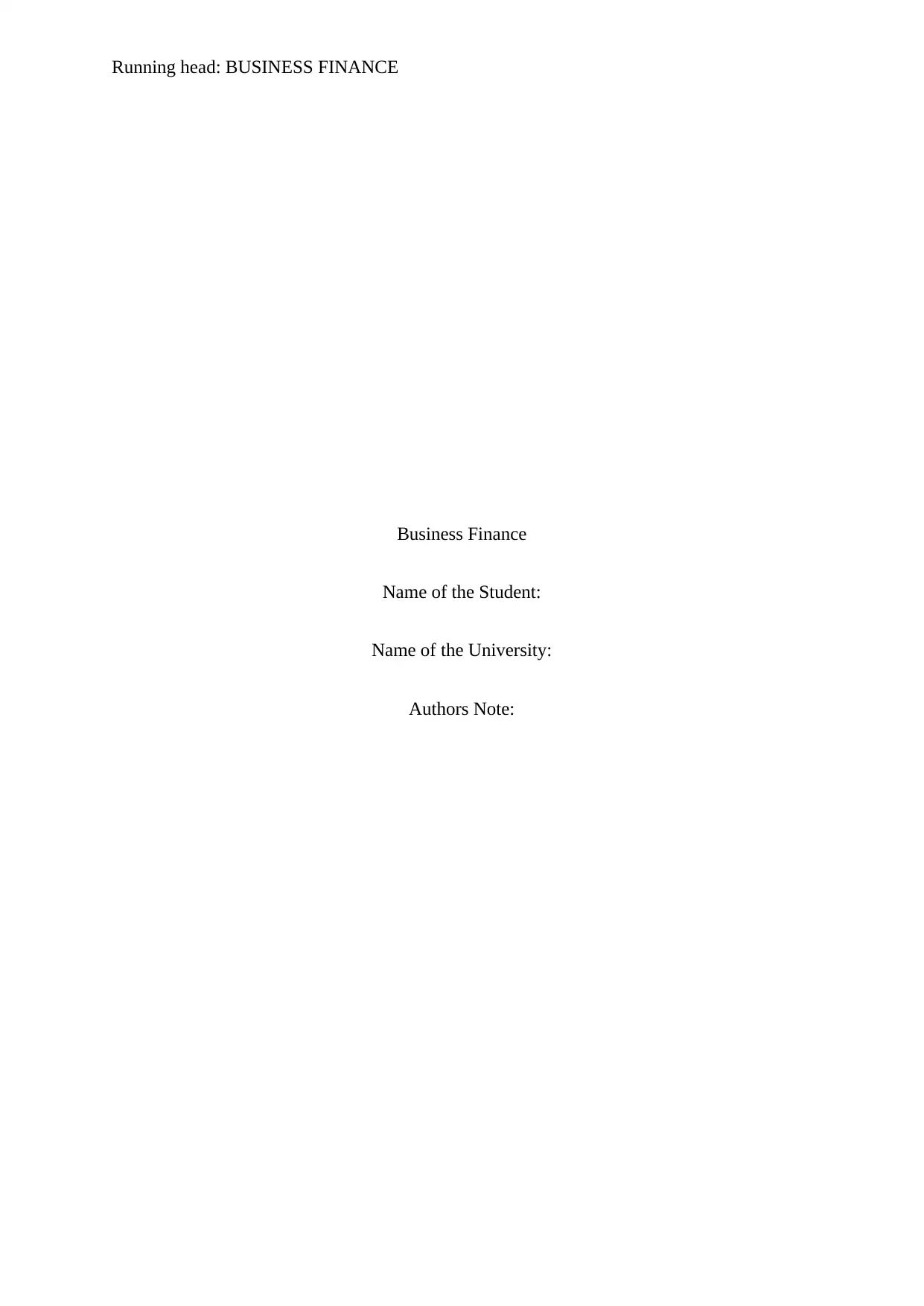
Running head: BUSINESS FINANCE
Business Finance
Name of the Student:
Name of the University:
Authors Note:
Business Finance
Name of the Student:
Name of the University:
Authors Note:
Secure Best Marks with AI Grader
Need help grading? Try our AI Grader for instant feedback on your assignments.
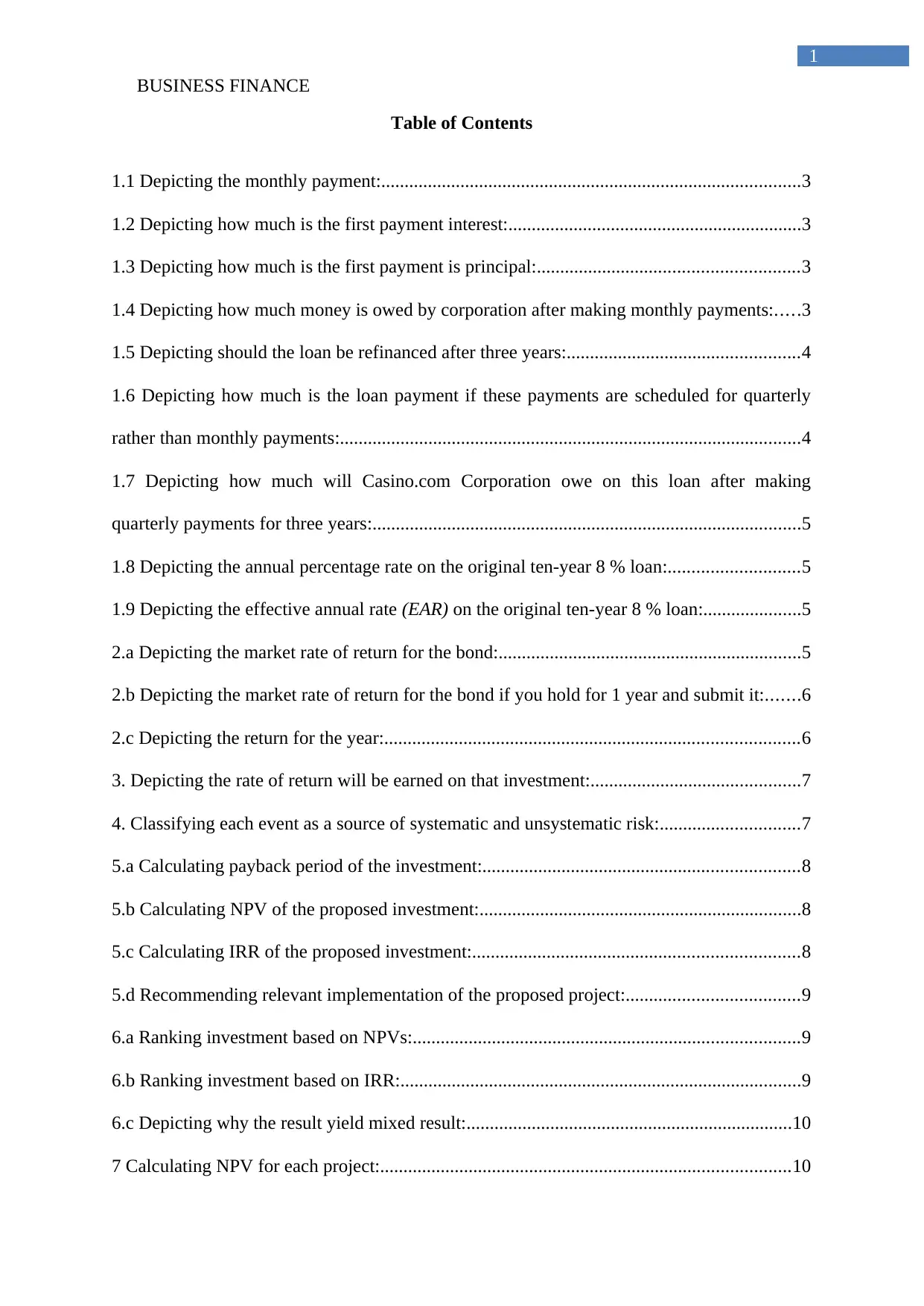
BUSINESS FINANCE
1
Table of Contents
1.1 Depicting the monthly payment:..........................................................................................3
1.2 Depicting how much is the first payment interest:...............................................................3
1.3 Depicting how much is the first payment is principal:........................................................3
1.4 Depicting how much money is owed by corporation after making monthly payments:.....3
1.5 Depicting should the loan be refinanced after three years:..................................................4
1.6 Depicting how much is the loan payment if these payments are scheduled for quarterly
rather than monthly payments:...................................................................................................4
1.7 Depicting how much will Casino.com Corporation owe on this loan after making
quarterly payments for three years:............................................................................................5
1.8 Depicting the annual percentage rate on the original ten-year 8 % loan:............................5
1.9 Depicting the effective annual rate (EAR) on the original ten-year 8 % loan:.....................5
2.a Depicting the market rate of return for the bond:.................................................................5
2.b Depicting the market rate of return for the bond if you hold for 1 year and submit it:.......6
2.c Depicting the return for the year:.........................................................................................6
3. Depicting the rate of return will be earned on that investment:.............................................7
4. Classifying each event as a source of systematic and unsystematic risk:..............................7
5.a Calculating payback period of the investment:....................................................................8
5.b Calculating NPV of the proposed investment:.....................................................................8
5.c Calculating IRR of the proposed investment:......................................................................8
5.d Recommending relevant implementation of the proposed project:.....................................9
6.a Ranking investment based on NPVs:...................................................................................9
6.b Ranking investment based on IRR:......................................................................................9
6.c Depicting why the result yield mixed result:......................................................................10
7 Calculating NPV for each project:........................................................................................10
1
Table of Contents
1.1 Depicting the monthly payment:..........................................................................................3
1.2 Depicting how much is the first payment interest:...............................................................3
1.3 Depicting how much is the first payment is principal:........................................................3
1.4 Depicting how much money is owed by corporation after making monthly payments:.....3
1.5 Depicting should the loan be refinanced after three years:..................................................4
1.6 Depicting how much is the loan payment if these payments are scheduled for quarterly
rather than monthly payments:...................................................................................................4
1.7 Depicting how much will Casino.com Corporation owe on this loan after making
quarterly payments for three years:............................................................................................5
1.8 Depicting the annual percentage rate on the original ten-year 8 % loan:............................5
1.9 Depicting the effective annual rate (EAR) on the original ten-year 8 % loan:.....................5
2.a Depicting the market rate of return for the bond:.................................................................5
2.b Depicting the market rate of return for the bond if you hold for 1 year and submit it:.......6
2.c Depicting the return for the year:.........................................................................................6
3. Depicting the rate of return will be earned on that investment:.............................................7
4. Classifying each event as a source of systematic and unsystematic risk:..............................7
5.a Calculating payback period of the investment:....................................................................8
5.b Calculating NPV of the proposed investment:.....................................................................8
5.c Calculating IRR of the proposed investment:......................................................................8
5.d Recommending relevant implementation of the proposed project:.....................................9
6.a Ranking investment based on NPVs:...................................................................................9
6.b Ranking investment based on IRR:......................................................................................9
6.c Depicting why the result yield mixed result:......................................................................10
7 Calculating NPV for each project:........................................................................................10
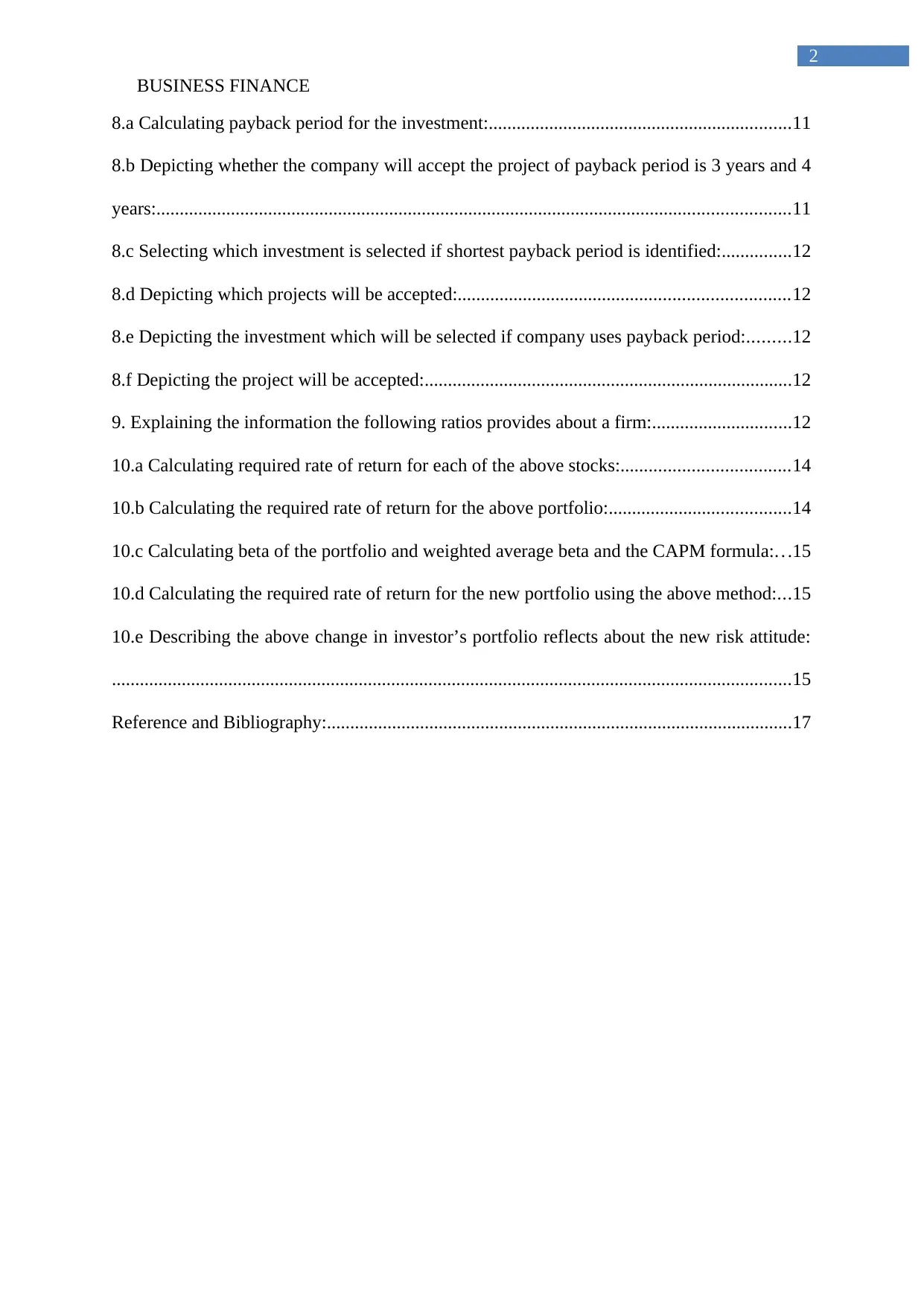
BUSINESS FINANCE
2
8.a Calculating payback period for the investment:.................................................................11
8.b Depicting whether the company will accept the project of payback period is 3 years and 4
years:........................................................................................................................................11
8.c Selecting which investment is selected if shortest payback period is identified:...............12
8.d Depicting which projects will be accepted:.......................................................................12
8.e Depicting the investment which will be selected if company uses payback period:.........12
8.f Depicting the project will be accepted:...............................................................................12
9. Explaining the information the following ratios provides about a firm:..............................12
10.a Calculating required rate of return for each of the above stocks:....................................14
10.b Calculating the required rate of return for the above portfolio:.......................................14
10.c Calculating beta of the portfolio and weighted average beta and the CAPM formula:. . .15
10.d Calculating the required rate of return for the new portfolio using the above method:...15
10.e Describing the above change in investor’s portfolio reflects about the new risk attitude:
..................................................................................................................................................15
Reference and Bibliography:....................................................................................................17
2
8.a Calculating payback period for the investment:.................................................................11
8.b Depicting whether the company will accept the project of payback period is 3 years and 4
years:........................................................................................................................................11
8.c Selecting which investment is selected if shortest payback period is identified:...............12
8.d Depicting which projects will be accepted:.......................................................................12
8.e Depicting the investment which will be selected if company uses payback period:.........12
8.f Depicting the project will be accepted:...............................................................................12
9. Explaining the information the following ratios provides about a firm:..............................12
10.a Calculating required rate of return for each of the above stocks:....................................14
10.b Calculating the required rate of return for the above portfolio:.......................................14
10.c Calculating beta of the portfolio and weighted average beta and the CAPM formula:. . .15
10.d Calculating the required rate of return for the new portfolio using the above method:...15
10.e Describing the above change in investor’s portfolio reflects about the new risk attitude:
..................................................................................................................................................15
Reference and Bibliography:....................................................................................................17
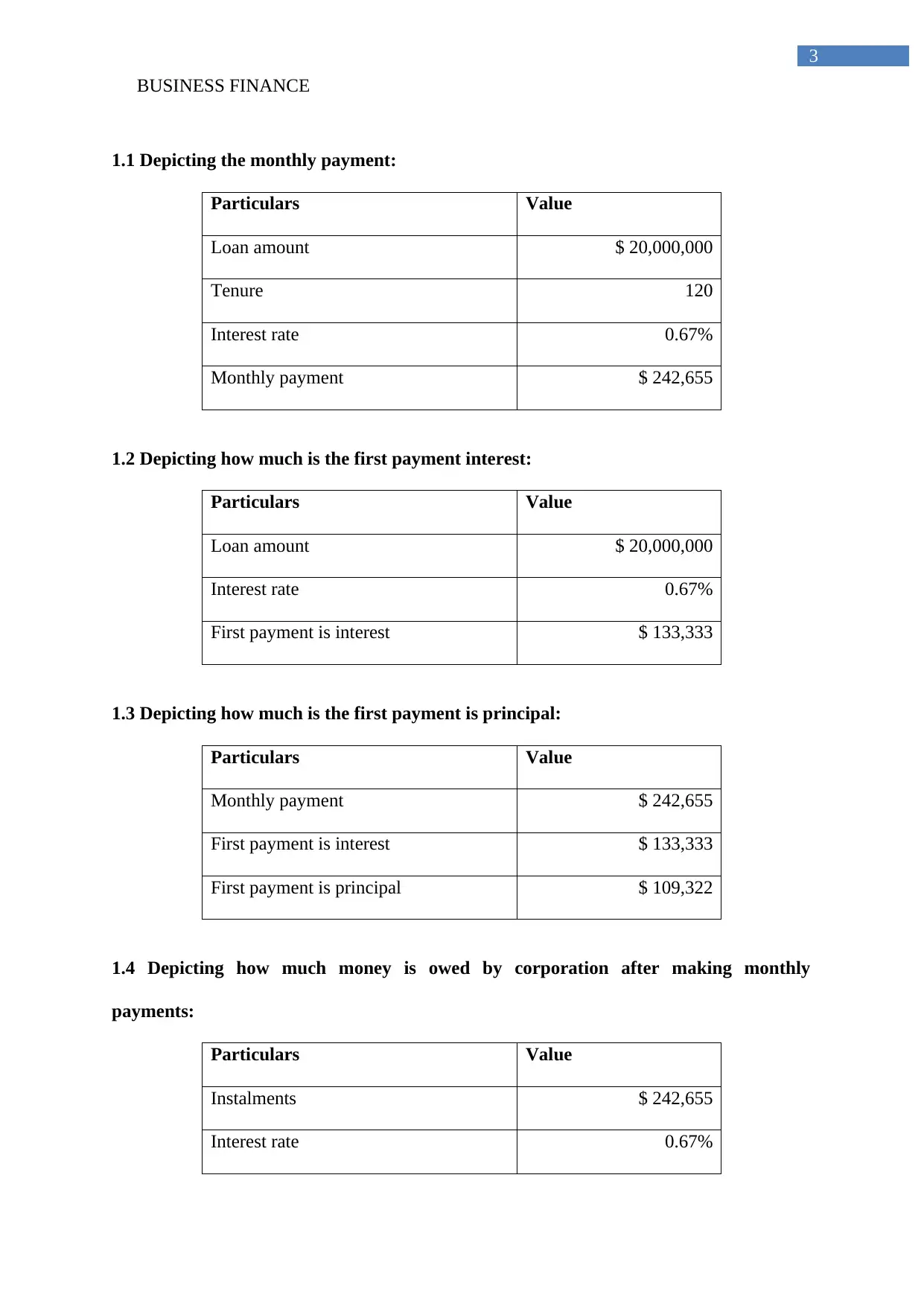
BUSINESS FINANCE
3
1.1 Depicting the monthly payment:
Particulars Value
Loan amount $ 20,000,000
Tenure 120
Interest rate 0.67%
Monthly payment $ 242,655
1.2 Depicting how much is the first payment interest:
Particulars Value
Loan amount $ 20,000,000
Interest rate 0.67%
First payment is interest $ 133,333
1.3 Depicting how much is the first payment is principal:
Particulars Value
Monthly payment $ 242,655
First payment is interest $ 133,333
First payment is principal $ 109,322
1.4 Depicting how much money is owed by corporation after making monthly
payments:
Particulars Value
Instalments $ 242,655
Interest rate 0.67%
3
1.1 Depicting the monthly payment:
Particulars Value
Loan amount $ 20,000,000
Tenure 120
Interest rate 0.67%
Monthly payment $ 242,655
1.2 Depicting how much is the first payment interest:
Particulars Value
Loan amount $ 20,000,000
Interest rate 0.67%
First payment is interest $ 133,333
1.3 Depicting how much is the first payment is principal:
Particulars Value
Monthly payment $ 242,655
First payment is interest $ 133,333
First payment is principal $ 109,322
1.4 Depicting how much money is owed by corporation after making monthly
payments:
Particulars Value
Instalments $ 242,655
Interest rate 0.67%
Secure Best Marks with AI Grader
Need help grading? Try our AI Grader for instant feedback on your assignments.
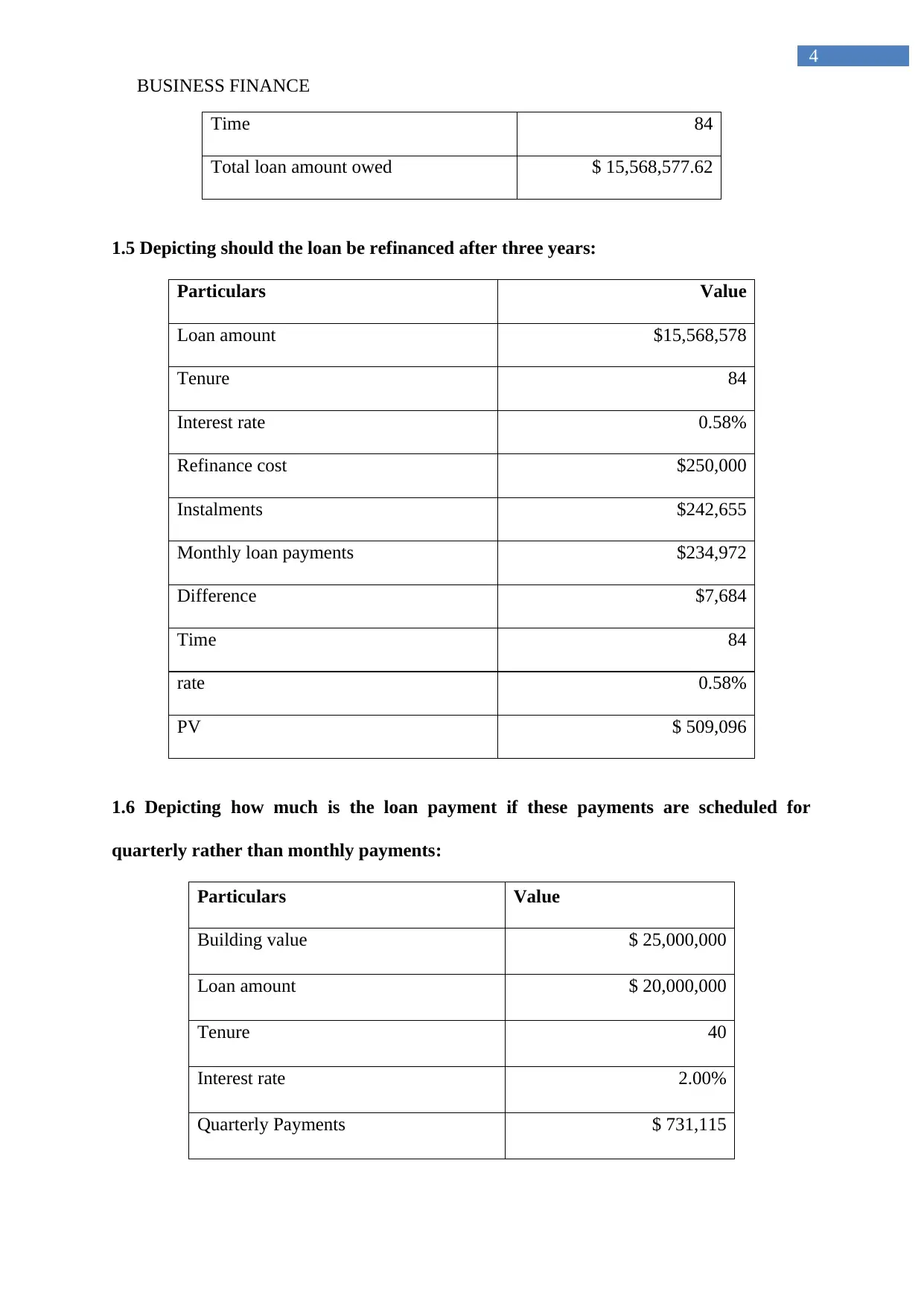
BUSINESS FINANCE
4
Time 84
Total loan amount owed $ 15,568,577.62
1.5 Depicting should the loan be refinanced after three years:
Particulars Value
Loan amount $15,568,578
Tenure 84
Interest rate 0.58%
Refinance cost $250,000
Instalments $242,655
Monthly loan payments $234,972
Difference $7,684
Time 84
rate 0.58%
PV $ 509,096
1.6 Depicting how much is the loan payment if these payments are scheduled for
quarterly rather than monthly payments:
Particulars Value
Building value $ 25,000,000
Loan amount $ 20,000,000
Tenure 40
Interest rate 2.00%
Quarterly Payments $ 731,115
4
Time 84
Total loan amount owed $ 15,568,577.62
1.5 Depicting should the loan be refinanced after three years:
Particulars Value
Loan amount $15,568,578
Tenure 84
Interest rate 0.58%
Refinance cost $250,000
Instalments $242,655
Monthly loan payments $234,972
Difference $7,684
Time 84
rate 0.58%
PV $ 509,096
1.6 Depicting how much is the loan payment if these payments are scheduled for
quarterly rather than monthly payments:
Particulars Value
Building value $ 25,000,000
Loan amount $ 20,000,000
Tenure 40
Interest rate 2.00%
Quarterly Payments $ 731,115
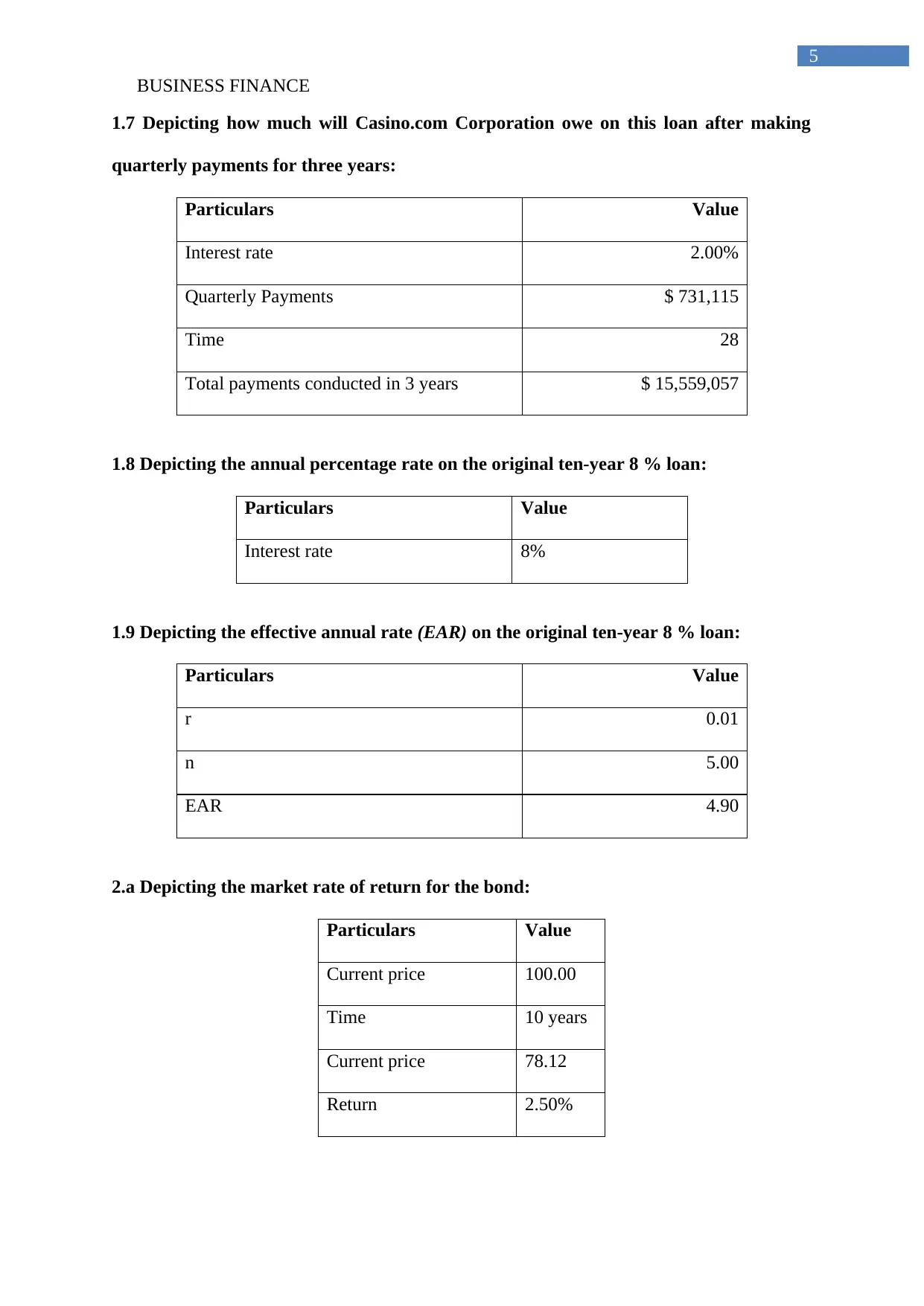
BUSINESS FINANCE
5
1.7 Depicting how much will Casino.com Corporation owe on this loan after making
quarterly payments for three years:
Particulars Value
Interest rate 2.00%
Quarterly Payments $ 731,115
Time 28
Total payments conducted in 3 years $ 15,559,057
1.8 Depicting the annual percentage rate on the original ten-year 8 % loan:
Particulars Value
Interest rate 8%
1.9 Depicting the effective annual rate (EAR) on the original ten-year 8 % loan:
Particulars Value
r 0.01
n 5.00
EAR 4.90
2.a Depicting the market rate of return for the bond:
Particulars Value
Current price 100.00
Time 10 years
Current price 78.12
Return 2.50%
5
1.7 Depicting how much will Casino.com Corporation owe on this loan after making
quarterly payments for three years:
Particulars Value
Interest rate 2.00%
Quarterly Payments $ 731,115
Time 28
Total payments conducted in 3 years $ 15,559,057
1.8 Depicting the annual percentage rate on the original ten-year 8 % loan:
Particulars Value
Interest rate 8%
1.9 Depicting the effective annual rate (EAR) on the original ten-year 8 % loan:
Particulars Value
r 0.01
n 5.00
EAR 4.90
2.a Depicting the market rate of return for the bond:
Particulars Value
Current price 100.00
Time 10 years
Current price 78.12
Return 2.50%
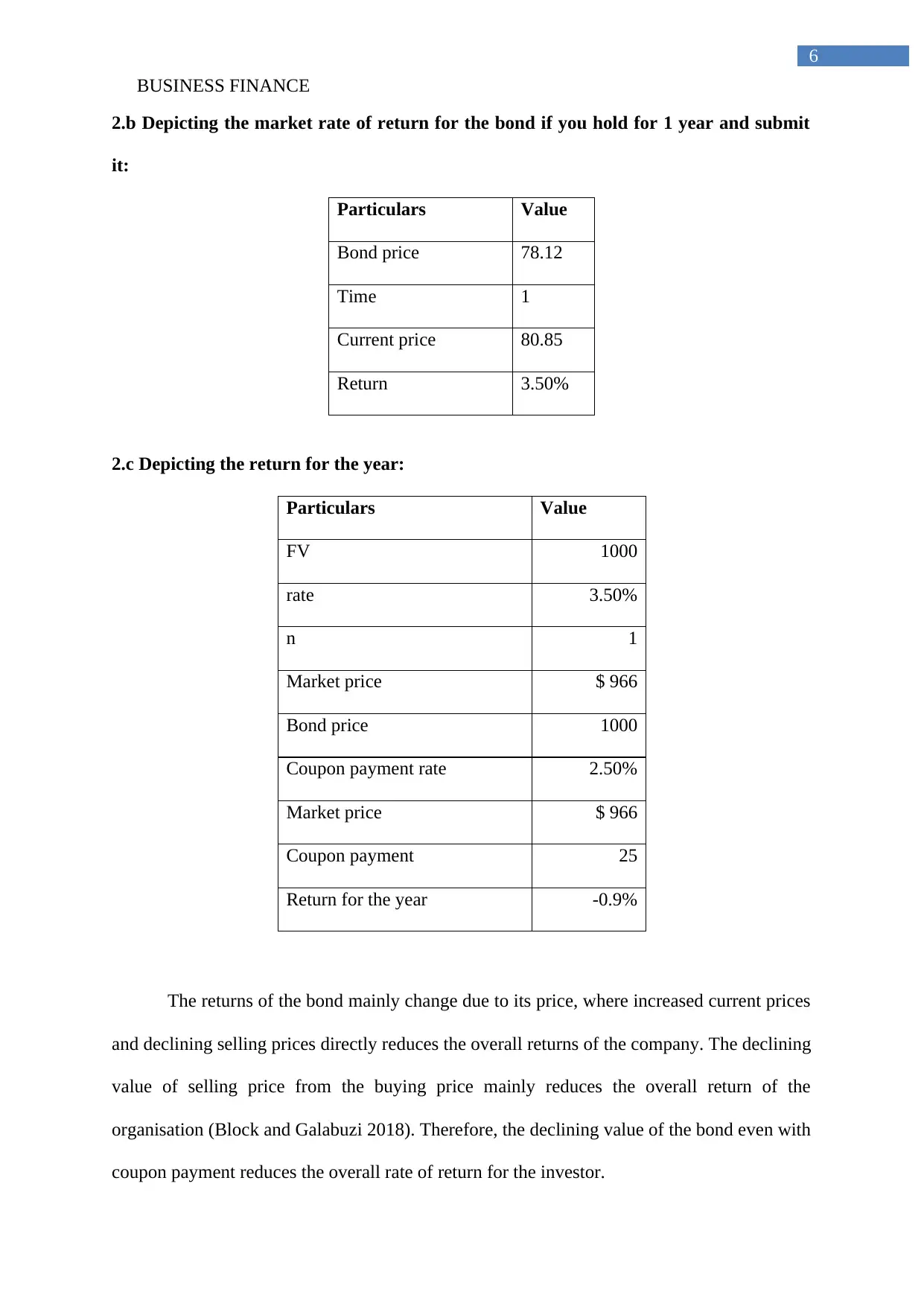
BUSINESS FINANCE
6
2.b Depicting the market rate of return for the bond if you hold for 1 year and submit
it:
Particulars Value
Bond price 78.12
Time 1
Current price 80.85
Return 3.50%
2.c Depicting the return for the year:
Particulars Value
FV 1000
rate 3.50%
n 1
Market price $ 966
Bond price 1000
Coupon payment rate 2.50%
Market price $ 966
Coupon payment 25
Return for the year -0.9%
The returns of the bond mainly change due to its price, where increased current prices
and declining selling prices directly reduces the overall returns of the company. The declining
value of selling price from the buying price mainly reduces the overall return of the
organisation (Block and Galabuzi 2018). Therefore, the declining value of the bond even with
coupon payment reduces the overall rate of return for the investor.
6
2.b Depicting the market rate of return for the bond if you hold for 1 year and submit
it:
Particulars Value
Bond price 78.12
Time 1
Current price 80.85
Return 3.50%
2.c Depicting the return for the year:
Particulars Value
FV 1000
rate 3.50%
n 1
Market price $ 966
Bond price 1000
Coupon payment rate 2.50%
Market price $ 966
Coupon payment 25
Return for the year -0.9%
The returns of the bond mainly change due to its price, where increased current prices
and declining selling prices directly reduces the overall returns of the company. The declining
value of selling price from the buying price mainly reduces the overall return of the
organisation (Block and Galabuzi 2018). Therefore, the declining value of the bond even with
coupon payment reduces the overall rate of return for the investor.
Paraphrase This Document
Need a fresh take? Get an instant paraphrase of this document with our AI Paraphraser
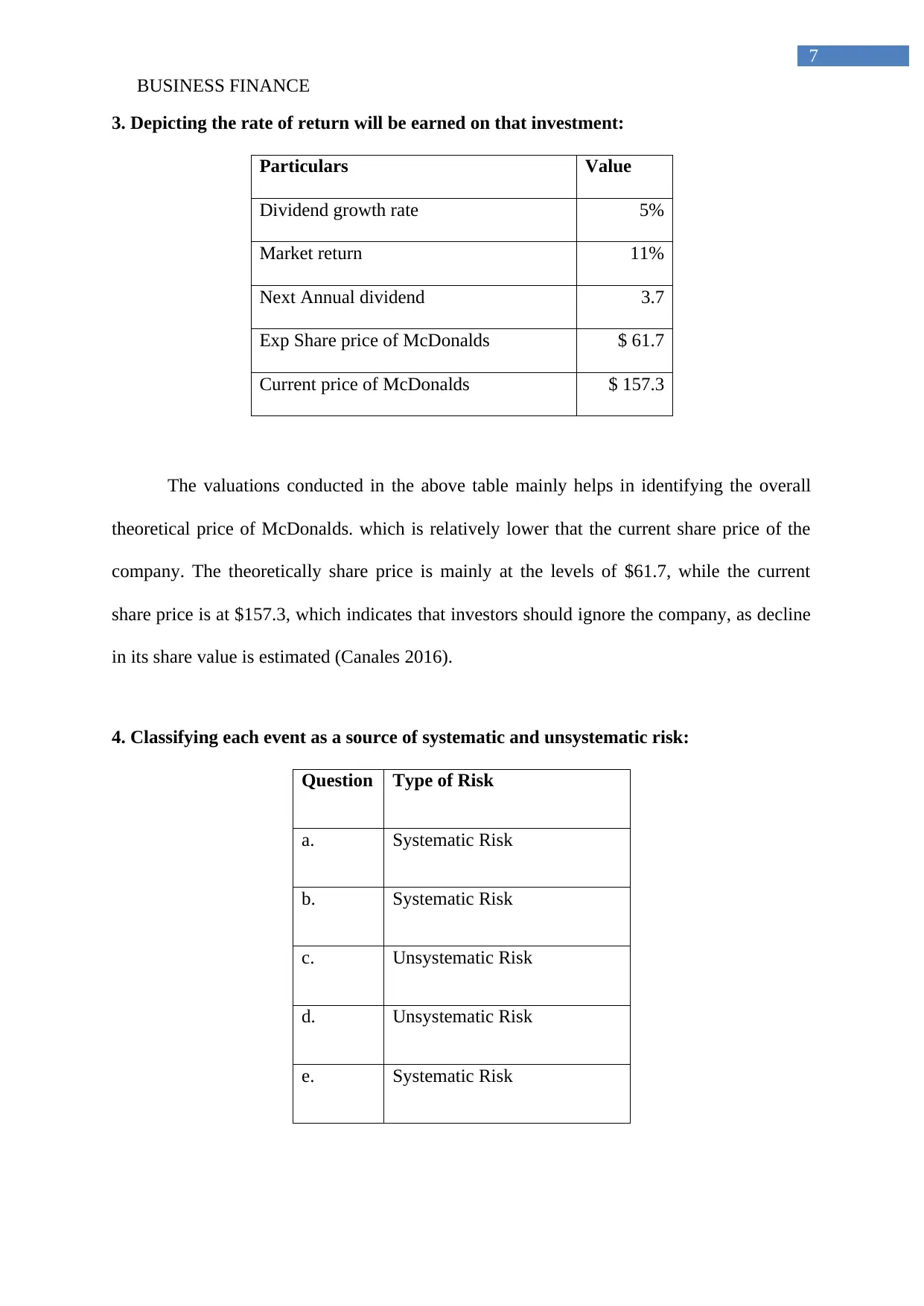
BUSINESS FINANCE
7
3. Depicting the rate of return will be earned on that investment:
Particulars Value
Dividend growth rate 5%
Market return 11%
Next Annual dividend 3.7
Exp Share price of McDonalds $ 61.7
Current price of McDonalds $ 157.3
The valuations conducted in the above table mainly helps in identifying the overall
theoretical price of McDonalds. which is relatively lower that the current share price of the
company. The theoretically share price is mainly at the levels of $61.7, while the current
share price is at $157.3, which indicates that investors should ignore the company, as decline
in its share value is estimated (Canales 2016).
4. Classifying each event as a source of systematic and unsystematic risk:
Question Type of Risk
a. Systematic Risk
b. Systematic Risk
c. Unsystematic Risk
d. Unsystematic Risk
e. Systematic Risk
7
3. Depicting the rate of return will be earned on that investment:
Particulars Value
Dividend growth rate 5%
Market return 11%
Next Annual dividend 3.7
Exp Share price of McDonalds $ 61.7
Current price of McDonalds $ 157.3
The valuations conducted in the above table mainly helps in identifying the overall
theoretical price of McDonalds. which is relatively lower that the current share price of the
company. The theoretically share price is mainly at the levels of $61.7, while the current
share price is at $157.3, which indicates that investors should ignore the company, as decline
in its share value is estimated (Canales 2016).
4. Classifying each event as a source of systematic and unsystematic risk:
Question Type of Risk
a. Systematic Risk
b. Systematic Risk
c. Unsystematic Risk
d. Unsystematic Risk
e. Systematic Risk
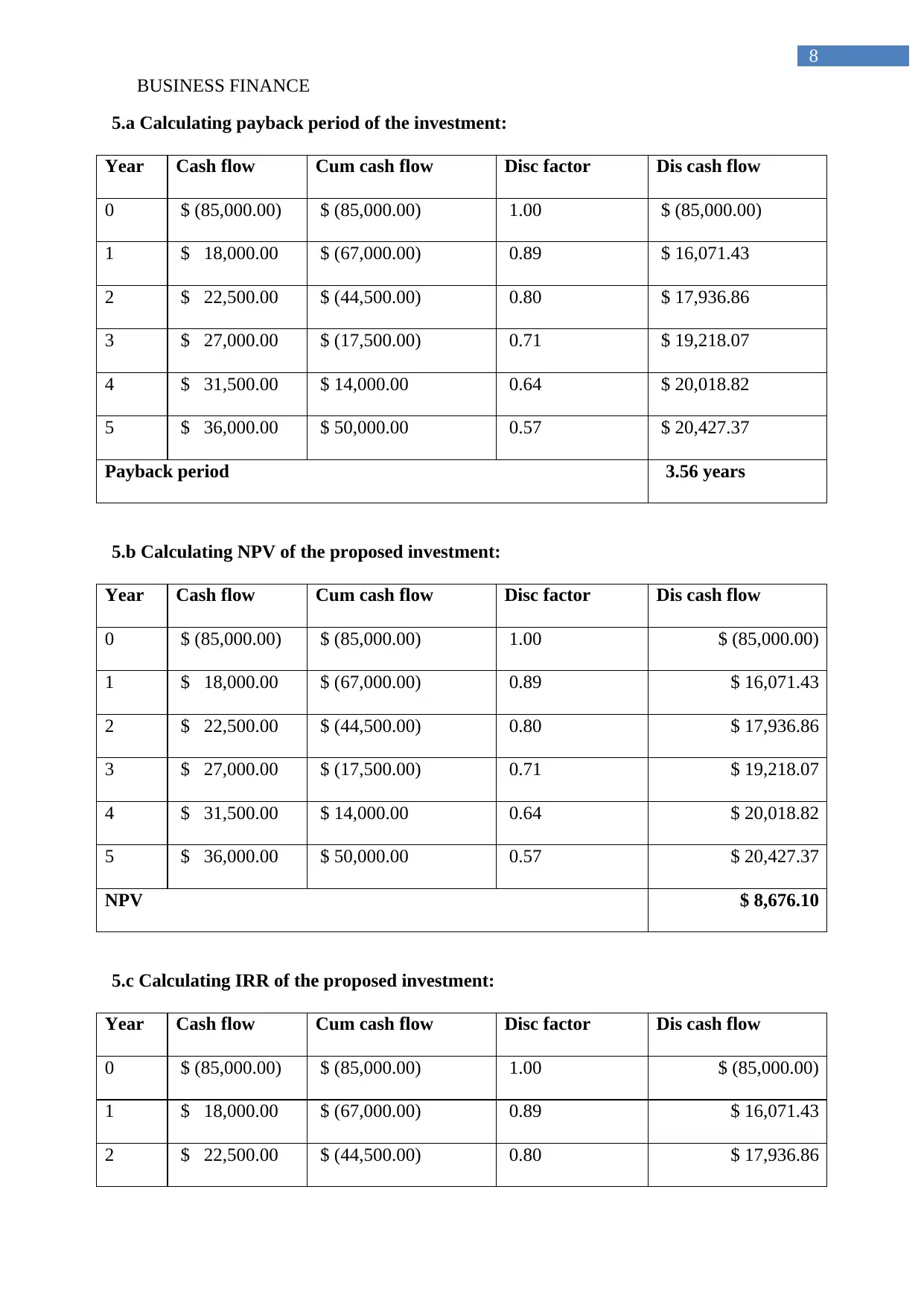
BUSINESS FINANCE
8
5.a Calculating payback period of the investment:
Year Cash flow Cum cash flow Disc factor Dis cash flow
0 $ (85,000.00) $ (85,000.00) 1.00 $ (85,000.00)
1 $ 18,000.00 $ (67,000.00) 0.89 $ 16,071.43
2 $ 22,500.00 $ (44,500.00) 0.80 $ 17,936.86
3 $ 27,000.00 $ (17,500.00) 0.71 $ 19,218.07
4 $ 31,500.00 $ 14,000.00 0.64 $ 20,018.82
5 $ 36,000.00 $ 50,000.00 0.57 $ 20,427.37
Payback period 3.56 years
5.b Calculating NPV of the proposed investment:
Year Cash flow Cum cash flow Disc factor Dis cash flow
0 $ (85,000.00) $ (85,000.00) 1.00 $ (85,000.00)
1 $ 18,000.00 $ (67,000.00) 0.89 $ 16,071.43
2 $ 22,500.00 $ (44,500.00) 0.80 $ 17,936.86
3 $ 27,000.00 $ (17,500.00) 0.71 $ 19,218.07
4 $ 31,500.00 $ 14,000.00 0.64 $ 20,018.82
5 $ 36,000.00 $ 50,000.00 0.57 $ 20,427.37
NPV $ 8,676.10
5.c Calculating IRR of the proposed investment:
Year Cash flow Cum cash flow Disc factor Dis cash flow
0 $ (85,000.00) $ (85,000.00) 1.00 $ (85,000.00)
1 $ 18,000.00 $ (67,000.00) 0.89 $ 16,071.43
2 $ 22,500.00 $ (44,500.00) 0.80 $ 17,936.86
8
5.a Calculating payback period of the investment:
Year Cash flow Cum cash flow Disc factor Dis cash flow
0 $ (85,000.00) $ (85,000.00) 1.00 $ (85,000.00)
1 $ 18,000.00 $ (67,000.00) 0.89 $ 16,071.43
2 $ 22,500.00 $ (44,500.00) 0.80 $ 17,936.86
3 $ 27,000.00 $ (17,500.00) 0.71 $ 19,218.07
4 $ 31,500.00 $ 14,000.00 0.64 $ 20,018.82
5 $ 36,000.00 $ 50,000.00 0.57 $ 20,427.37
Payback period 3.56 years
5.b Calculating NPV of the proposed investment:
Year Cash flow Cum cash flow Disc factor Dis cash flow
0 $ (85,000.00) $ (85,000.00) 1.00 $ (85,000.00)
1 $ 18,000.00 $ (67,000.00) 0.89 $ 16,071.43
2 $ 22,500.00 $ (44,500.00) 0.80 $ 17,936.86
3 $ 27,000.00 $ (17,500.00) 0.71 $ 19,218.07
4 $ 31,500.00 $ 14,000.00 0.64 $ 20,018.82
5 $ 36,000.00 $ 50,000.00 0.57 $ 20,427.37
NPV $ 8,676.10
5.c Calculating IRR of the proposed investment:
Year Cash flow Cum cash flow Disc factor Dis cash flow
0 $ (85,000.00) $ (85,000.00) 1.00 $ (85,000.00)
1 $ 18,000.00 $ (67,000.00) 0.89 $ 16,071.43
2 $ 22,500.00 $ (44,500.00) 0.80 $ 17,936.86
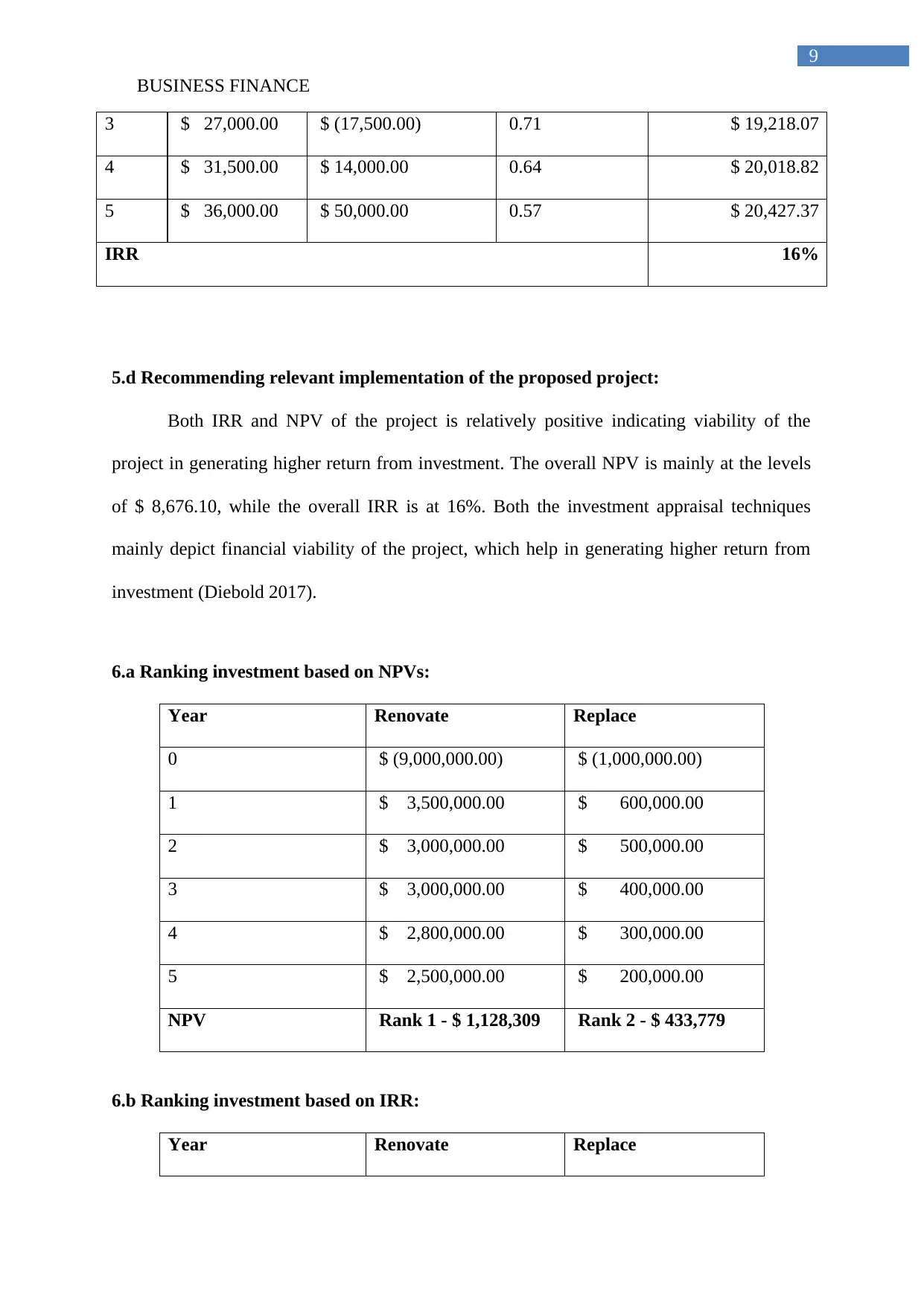
BUSINESS FINANCE
9
3 $ 27,000.00 $ (17,500.00) 0.71 $ 19,218.07
4 $ 31,500.00 $ 14,000.00 0.64 $ 20,018.82
5 $ 36,000.00 $ 50,000.00 0.57 $ 20,427.37
IRR 16%
5.d Recommending relevant implementation of the proposed project:
Both IRR and NPV of the project is relatively positive indicating viability of the
project in generating higher return from investment. The overall NPV is mainly at the levels
of $ 8,676.10, while the overall IRR is at 16%. Both the investment appraisal techniques
mainly depict financial viability of the project, which help in generating higher return from
investment (Diebold 2017).
6.a Ranking investment based on NPVs:
Year Renovate Replace
0 $ (9,000,000.00) $ (1,000,000.00)
1 $ 3,500,000.00 $ 600,000.00
2 $ 3,000,000.00 $ 500,000.00
3 $ 3,000,000.00 $ 400,000.00
4 $ 2,800,000.00 $ 300,000.00
5 $ 2,500,000.00 $ 200,000.00
NPV Rank 1 - $ 1,128,309 Rank 2 - $ 433,779
6.b Ranking investment based on IRR:
Year Renovate Replace
9
3 $ 27,000.00 $ (17,500.00) 0.71 $ 19,218.07
4 $ 31,500.00 $ 14,000.00 0.64 $ 20,018.82
5 $ 36,000.00 $ 50,000.00 0.57 $ 20,427.37
IRR 16%
5.d Recommending relevant implementation of the proposed project:
Both IRR and NPV of the project is relatively positive indicating viability of the
project in generating higher return from investment. The overall NPV is mainly at the levels
of $ 8,676.10, while the overall IRR is at 16%. Both the investment appraisal techniques
mainly depict financial viability of the project, which help in generating higher return from
investment (Diebold 2017).
6.a Ranking investment based on NPVs:
Year Renovate Replace
0 $ (9,000,000.00) $ (1,000,000.00)
1 $ 3,500,000.00 $ 600,000.00
2 $ 3,000,000.00 $ 500,000.00
3 $ 3,000,000.00 $ 400,000.00
4 $ 2,800,000.00 $ 300,000.00
5 $ 2,500,000.00 $ 200,000.00
NPV Rank 1 - $ 1,128,309 Rank 2 - $ 433,779
6.b Ranking investment based on IRR:
Year Renovate Replace
Secure Best Marks with AI Grader
Need help grading? Try our AI Grader for instant feedback on your assignments.
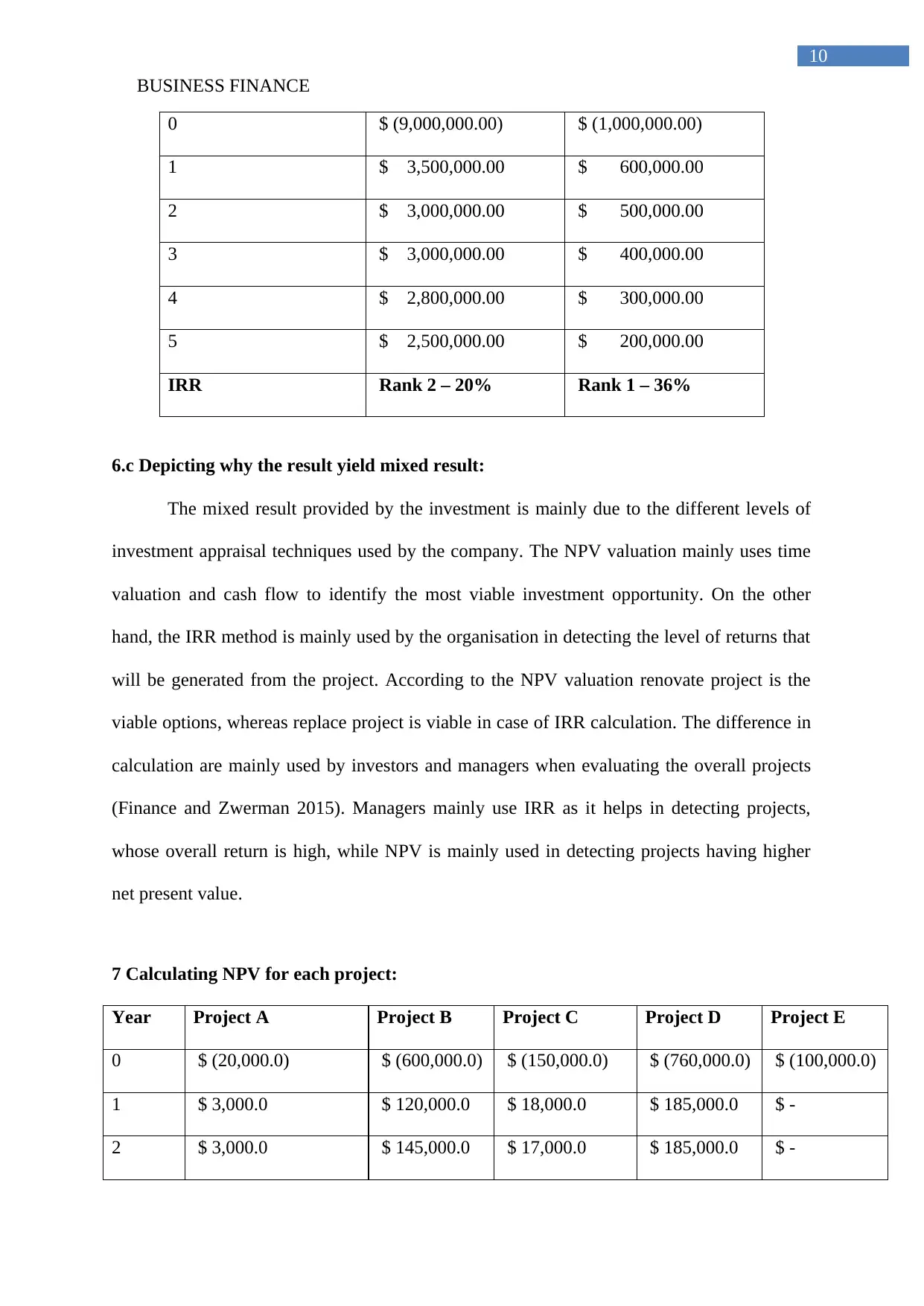
BUSINESS FINANCE
10
0 $ (9,000,000.00) $ (1,000,000.00)
1 $ 3,500,000.00 $ 600,000.00
2 $ 3,000,000.00 $ 500,000.00
3 $ 3,000,000.00 $ 400,000.00
4 $ 2,800,000.00 $ 300,000.00
5 $ 2,500,000.00 $ 200,000.00
IRR Rank 2 – 20% Rank 1 – 36%
6.c Depicting why the result yield mixed result:
The mixed result provided by the investment is mainly due to the different levels of
investment appraisal techniques used by the company. The NPV valuation mainly uses time
valuation and cash flow to identify the most viable investment opportunity. On the other
hand, the IRR method is mainly used by the organisation in detecting the level of returns that
will be generated from the project. According to the NPV valuation renovate project is the
viable options, whereas replace project is viable in case of IRR calculation. The difference in
calculation are mainly used by investors and managers when evaluating the overall projects
(Finance and Zwerman 2015). Managers mainly use IRR as it helps in detecting projects,
whose overall return is high, while NPV is mainly used in detecting projects having higher
net present value.
7 Calculating NPV for each project:
Year Project A Project B Project C Project D Project E
0 $ (20,000.0) $ (600,000.0) $ (150,000.0) $ (760,000.0) $ (100,000.0)
1 $ 3,000.0 $ 120,000.0 $ 18,000.0 $ 185,000.0 $ -
2 $ 3,000.0 $ 145,000.0 $ 17,000.0 $ 185,000.0 $ -
10
0 $ (9,000,000.00) $ (1,000,000.00)
1 $ 3,500,000.00 $ 600,000.00
2 $ 3,000,000.00 $ 500,000.00
3 $ 3,000,000.00 $ 400,000.00
4 $ 2,800,000.00 $ 300,000.00
5 $ 2,500,000.00 $ 200,000.00
IRR Rank 2 – 20% Rank 1 – 36%
6.c Depicting why the result yield mixed result:
The mixed result provided by the investment is mainly due to the different levels of
investment appraisal techniques used by the company. The NPV valuation mainly uses time
valuation and cash flow to identify the most viable investment opportunity. On the other
hand, the IRR method is mainly used by the organisation in detecting the level of returns that
will be generated from the project. According to the NPV valuation renovate project is the
viable options, whereas replace project is viable in case of IRR calculation. The difference in
calculation are mainly used by investors and managers when evaluating the overall projects
(Finance and Zwerman 2015). Managers mainly use IRR as it helps in detecting projects,
whose overall return is high, while NPV is mainly used in detecting projects having higher
net present value.
7 Calculating NPV for each project:
Year Project A Project B Project C Project D Project E
0 $ (20,000.0) $ (600,000.0) $ (150,000.0) $ (760,000.0) $ (100,000.0)
1 $ 3,000.0 $ 120,000.0 $ 18,000.0 $ 185,000.0 $ -
2 $ 3,000.0 $ 145,000.0 $ 17,000.0 $ 185,000.0 $ -
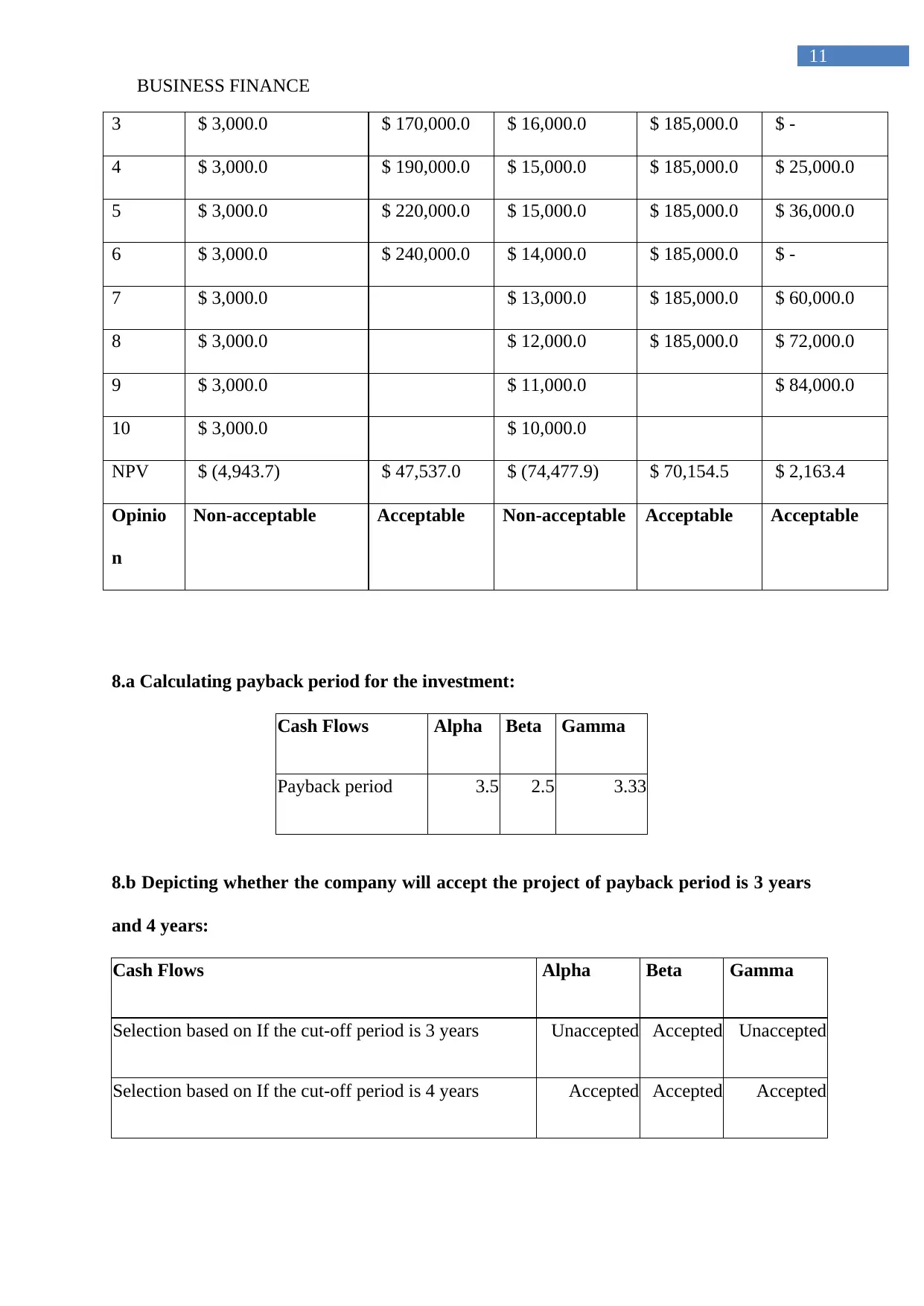
BUSINESS FINANCE
11
3 $ 3,000.0 $ 170,000.0 $ 16,000.0 $ 185,000.0 $ -
4 $ 3,000.0 $ 190,000.0 $ 15,000.0 $ 185,000.0 $ 25,000.0
5 $ 3,000.0 $ 220,000.0 $ 15,000.0 $ 185,000.0 $ 36,000.0
6 $ 3,000.0 $ 240,000.0 $ 14,000.0 $ 185,000.0 $ -
7 $ 3,000.0 $ 13,000.0 $ 185,000.0 $ 60,000.0
8 $ 3,000.0 $ 12,000.0 $ 185,000.0 $ 72,000.0
9 $ 3,000.0 $ 11,000.0 $ 84,000.0
10 $ 3,000.0 $ 10,000.0
NPV $ (4,943.7) $ 47,537.0 $ (74,477.9) $ 70,154.5 $ 2,163.4
Opinio
n
Non-acceptable Acceptable Non-acceptable Acceptable Acceptable
8.a Calculating payback period for the investment:
Cash Flows Alpha Beta Gamma
Payback period 3.5 2.5 3.33
8.b Depicting whether the company will accept the project of payback period is 3 years
and 4 years:
Cash Flows Alpha Beta Gamma
Selection based on If the cut-off period is 3 years Unaccepted Accepted Unaccepted
Selection based on If the cut-off period is 4 years Accepted Accepted Accepted
11
3 $ 3,000.0 $ 170,000.0 $ 16,000.0 $ 185,000.0 $ -
4 $ 3,000.0 $ 190,000.0 $ 15,000.0 $ 185,000.0 $ 25,000.0
5 $ 3,000.0 $ 220,000.0 $ 15,000.0 $ 185,000.0 $ 36,000.0
6 $ 3,000.0 $ 240,000.0 $ 14,000.0 $ 185,000.0 $ -
7 $ 3,000.0 $ 13,000.0 $ 185,000.0 $ 60,000.0
8 $ 3,000.0 $ 12,000.0 $ 185,000.0 $ 72,000.0
9 $ 3,000.0 $ 11,000.0 $ 84,000.0
10 $ 3,000.0 $ 10,000.0
NPV $ (4,943.7) $ 47,537.0 $ (74,477.9) $ 70,154.5 $ 2,163.4
Opinio
n
Non-acceptable Acceptable Non-acceptable Acceptable Acceptable
8.a Calculating payback period for the investment:
Cash Flows Alpha Beta Gamma
Payback period 3.5 2.5 3.33
8.b Depicting whether the company will accept the project of payback period is 3 years
and 4 years:
Cash Flows Alpha Beta Gamma
Selection based on If the cut-off period is 3 years Unaccepted Accepted Unaccepted
Selection based on If the cut-off period is 4 years Accepted Accepted Accepted
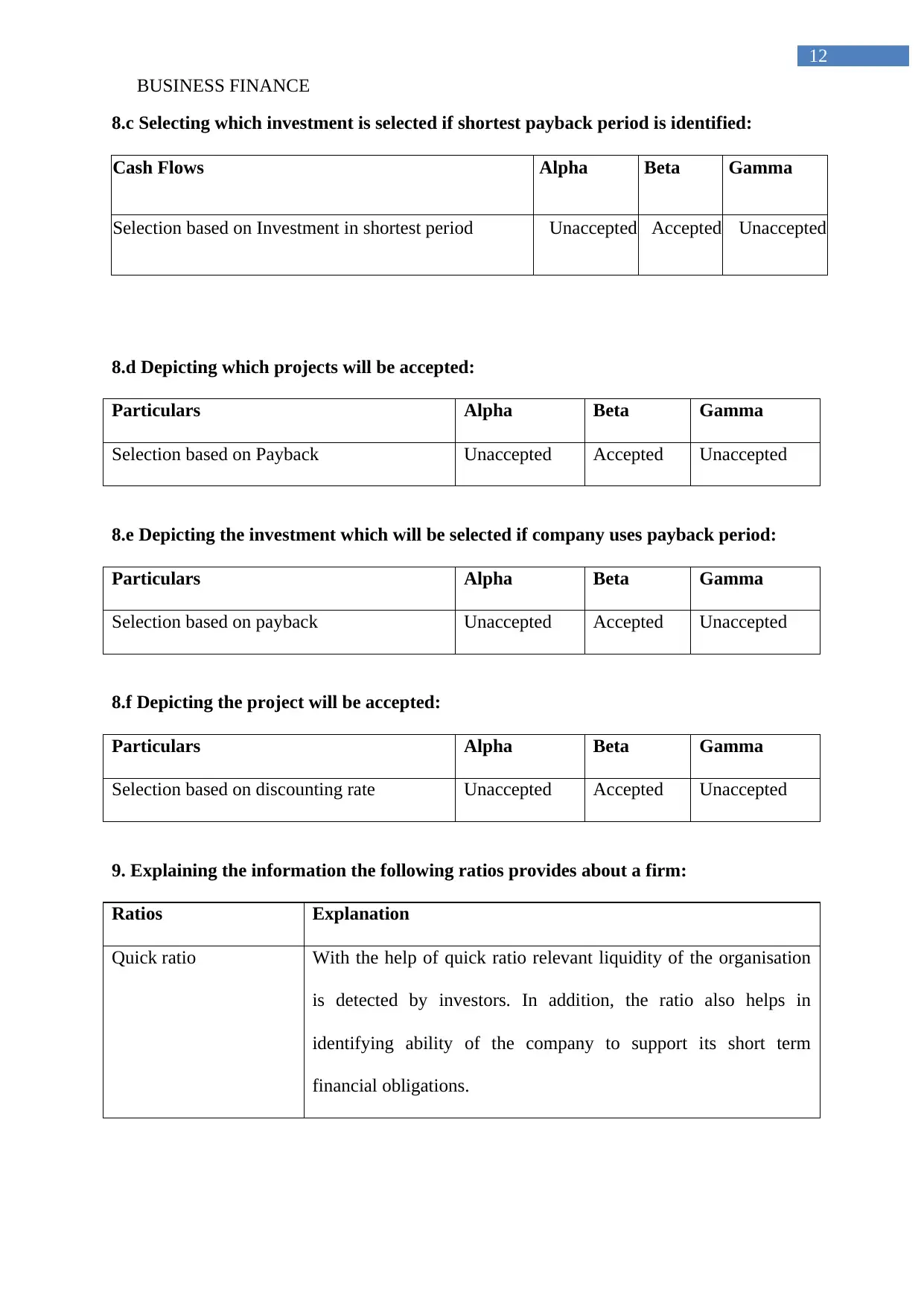
BUSINESS FINANCE
12
8.c Selecting which investment is selected if shortest payback period is identified:
Cash Flows Alpha Beta Gamma
Selection based on Investment in shortest period Unaccepted Accepted Unaccepted
8.d Depicting which projects will be accepted:
Particulars Alpha Beta Gamma
Selection based on Payback Unaccepted Accepted Unaccepted
8.e Depicting the investment which will be selected if company uses payback period:
Particulars Alpha Beta Gamma
Selection based on payback Unaccepted Accepted Unaccepted
8.f Depicting the project will be accepted:
Particulars Alpha Beta Gamma
Selection based on discounting rate Unaccepted Accepted Unaccepted
9. Explaining the information the following ratios provides about a firm:
Ratios Explanation
Quick ratio With the help of quick ratio relevant liquidity of the organisation
is detected by investors. In addition, the ratio also helps in
identifying ability of the company to support its short term
financial obligations.
12
8.c Selecting which investment is selected if shortest payback period is identified:
Cash Flows Alpha Beta Gamma
Selection based on Investment in shortest period Unaccepted Accepted Unaccepted
8.d Depicting which projects will be accepted:
Particulars Alpha Beta Gamma
Selection based on Payback Unaccepted Accepted Unaccepted
8.e Depicting the investment which will be selected if company uses payback period:
Particulars Alpha Beta Gamma
Selection based on payback Unaccepted Accepted Unaccepted
8.f Depicting the project will be accepted:
Particulars Alpha Beta Gamma
Selection based on discounting rate Unaccepted Accepted Unaccepted
9. Explaining the information the following ratios provides about a firm:
Ratios Explanation
Quick ratio With the help of quick ratio relevant liquidity of the organisation
is detected by investors. In addition, the ratio also helps in
identifying ability of the company to support its short term
financial obligations.
Paraphrase This Document
Need a fresh take? Get an instant paraphrase of this document with our AI Paraphraser
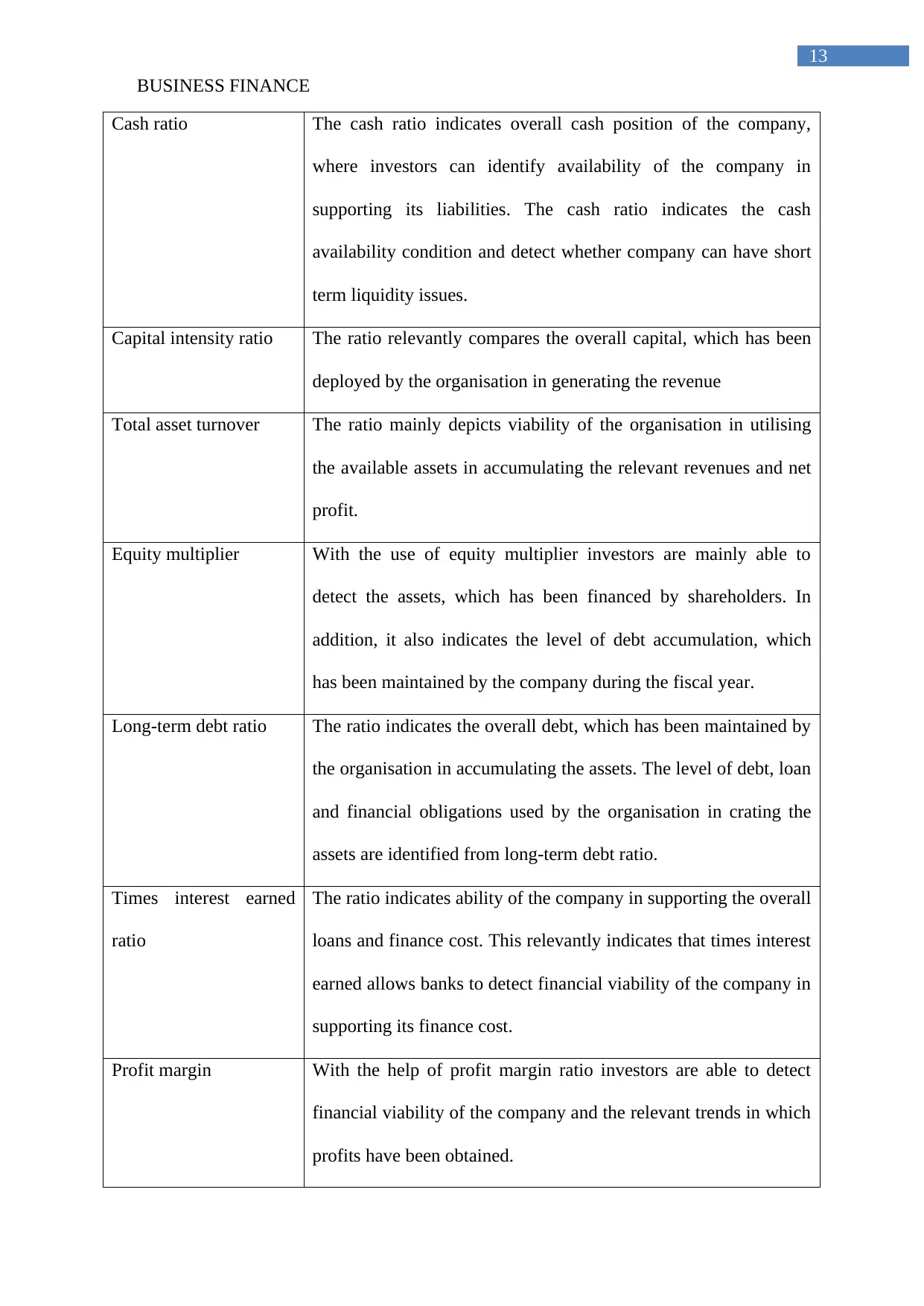
BUSINESS FINANCE
13
Cash ratio The cash ratio indicates overall cash position of the company,
where investors can identify availability of the company in
supporting its liabilities. The cash ratio indicates the cash
availability condition and detect whether company can have short
term liquidity issues.
Capital intensity ratio The ratio relevantly compares the overall capital, which has been
deployed by the organisation in generating the revenue
Total asset turnover The ratio mainly depicts viability of the organisation in utilising
the available assets in accumulating the relevant revenues and net
profit.
Equity multiplier With the use of equity multiplier investors are mainly able to
detect the assets, which has been financed by shareholders. In
addition, it also indicates the level of debt accumulation, which
has been maintained by the company during the fiscal year.
Long-term debt ratio The ratio indicates the overall debt, which has been maintained by
the organisation in accumulating the assets. The level of debt, loan
and financial obligations used by the organisation in crating the
assets are identified from long-term debt ratio.
Times interest earned
ratio
The ratio indicates ability of the company in supporting the overall
loans and finance cost. This relevantly indicates that times interest
earned allows banks to detect financial viability of the company in
supporting its finance cost.
Profit margin With the help of profit margin ratio investors are able to detect
financial viability of the company and the relevant trends in which
profits have been obtained.
13
Cash ratio The cash ratio indicates overall cash position of the company,
where investors can identify availability of the company in
supporting its liabilities. The cash ratio indicates the cash
availability condition and detect whether company can have short
term liquidity issues.
Capital intensity ratio The ratio relevantly compares the overall capital, which has been
deployed by the organisation in generating the revenue
Total asset turnover The ratio mainly depicts viability of the organisation in utilising
the available assets in accumulating the relevant revenues and net
profit.
Equity multiplier With the use of equity multiplier investors are mainly able to
detect the assets, which has been financed by shareholders. In
addition, it also indicates the level of debt accumulation, which
has been maintained by the company during the fiscal year.
Long-term debt ratio The ratio indicates the overall debt, which has been maintained by
the organisation in accumulating the assets. The level of debt, loan
and financial obligations used by the organisation in crating the
assets are identified from long-term debt ratio.
Times interest earned
ratio
The ratio indicates ability of the company in supporting the overall
loans and finance cost. This relevantly indicates that times interest
earned allows banks to detect financial viability of the company in
supporting its finance cost.
Profit margin With the help of profit margin ratio investors are able to detect
financial viability of the company and the relevant trends in which
profits have been obtained.
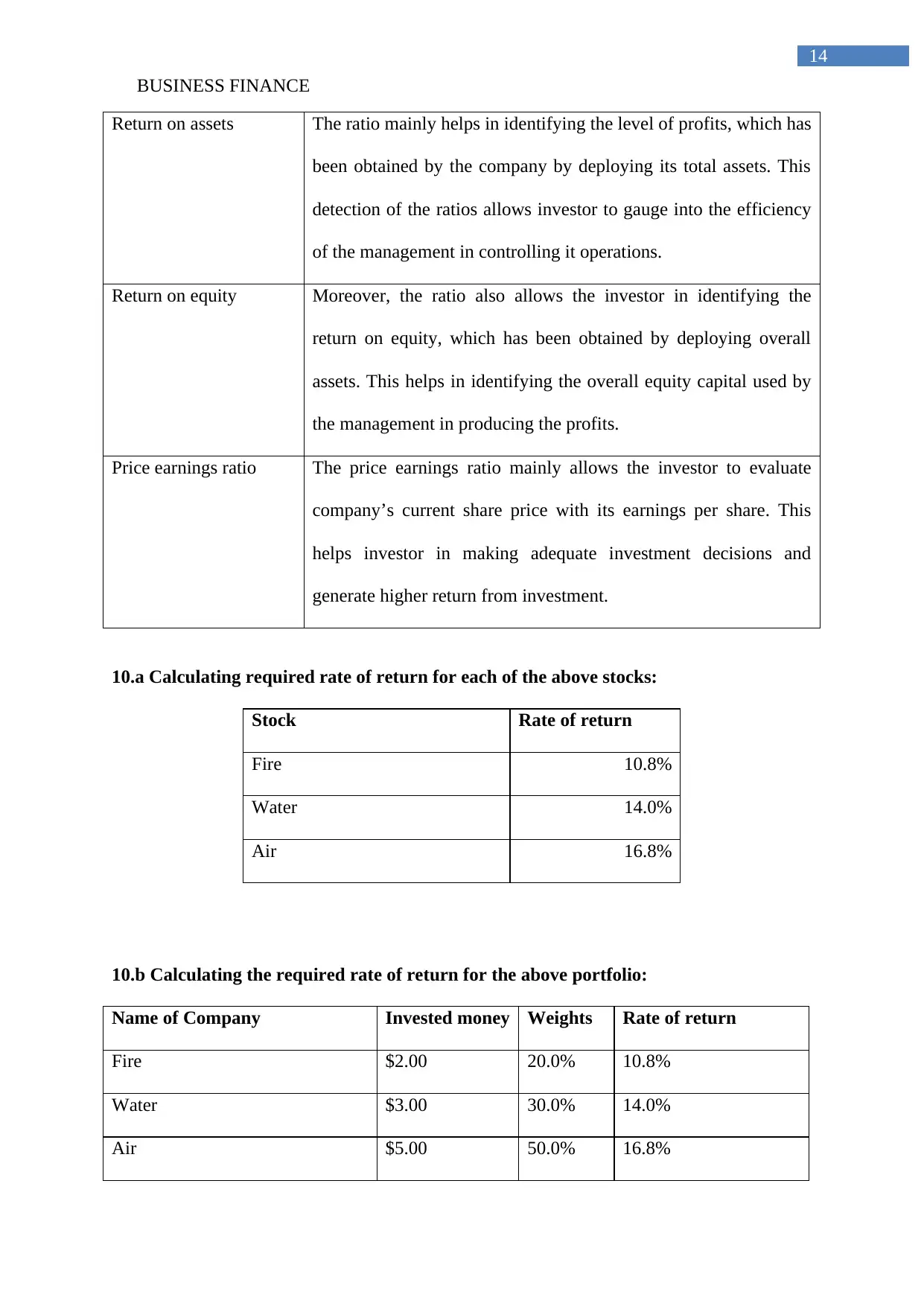
BUSINESS FINANCE
14
Return on assets The ratio mainly helps in identifying the level of profits, which has
been obtained by the company by deploying its total assets. This
detection of the ratios allows investor to gauge into the efficiency
of the management in controlling it operations.
Return on equity Moreover, the ratio also allows the investor in identifying the
return on equity, which has been obtained by deploying overall
assets. This helps in identifying the overall equity capital used by
the management in producing the profits.
Price earnings ratio The price earnings ratio mainly allows the investor to evaluate
company’s current share price with its earnings per share. This
helps investor in making adequate investment decisions and
generate higher return from investment.
10.a Calculating required rate of return for each of the above stocks:
Stock Rate of return
Fire 10.8%
Water 14.0%
Air 16.8%
10.b Calculating the required rate of return for the above portfolio:
Name of Company Invested money Weights Rate of return
Fire $2.00 20.0% 10.8%
Water $3.00 30.0% 14.0%
Air $5.00 50.0% 16.8%
14
Return on assets The ratio mainly helps in identifying the level of profits, which has
been obtained by the company by deploying its total assets. This
detection of the ratios allows investor to gauge into the efficiency
of the management in controlling it operations.
Return on equity Moreover, the ratio also allows the investor in identifying the
return on equity, which has been obtained by deploying overall
assets. This helps in identifying the overall equity capital used by
the management in producing the profits.
Price earnings ratio The price earnings ratio mainly allows the investor to evaluate
company’s current share price with its earnings per share. This
helps investor in making adequate investment decisions and
generate higher return from investment.
10.a Calculating required rate of return for each of the above stocks:
Stock Rate of return
Fire 10.8%
Water 14.0%
Air 16.8%
10.b Calculating the required rate of return for the above portfolio:
Name of Company Invested money Weights Rate of return
Fire $2.00 20.0% 10.8%
Water $3.00 30.0% 14.0%
Air $5.00 50.0% 16.8%
1 out of 15
Related Documents
Your All-in-One AI-Powered Toolkit for Academic Success.
+13062052269
info@desklib.com
Available 24*7 on WhatsApp / Email
![[object Object]](/_next/static/media/star-bottom.7253800d.svg)
Unlock your academic potential
© 2024 | Zucol Services PVT LTD | All rights reserved.




